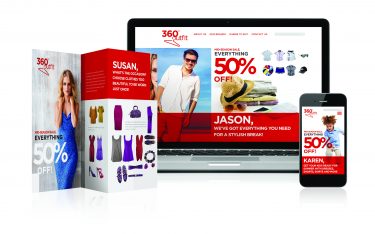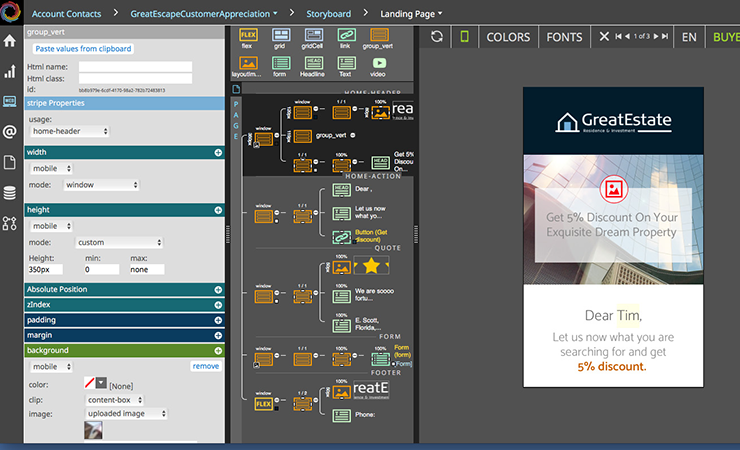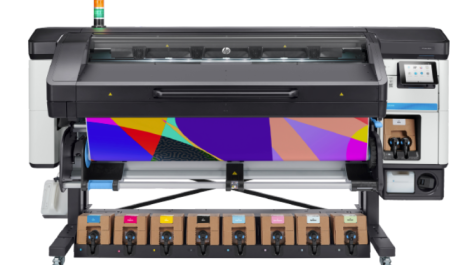Multi-channel is the current description for promotional campaigns that combine several media channels to reach the target audience, often with some degree of personalisation. Simon Eccles looks at where print fits in.
The name keeps changing but the concept remains broadly the same. Analytics are today an important part of what we recently called cross-media campaigns, and indeed the main point of them for some users. Printing has historically struggled with measurable response rates, compared with the immediacy of reported website clicks, times and e-mail opens. Print innovations such as personalised QR codes or printed PURLs are now a decade old but still quite rarely seen or, it seems, acted upon by recipients. All the same, printing remains an important part of many multi-channel campaigns, or at least many of those initiated by printers as a customer service.
Multi-channel is rather like variable data printing, in that it’s presented as a valuable way for printers to add services and revenue streams that go beyond the increasingly commoditised short run CMYK work. However, like VDP, there are some exceptionally well-organised companies doing it and doing it well, but the vast majority doesn’t yet.
David Baldaro, product marketing manager at XMPie UK, believes that print service providers need to be far more proactive to open their customers’ eyes to the possibilities. ‘PSPs tend not to have active conversations with their customers,’ he finds. ‘It involves marketing and campaigns and it’s a much longer conversation. They ask themselves “do I have the credibility or even the terminology to go and have these conversations?” A few do it very well, as they have dropped the print mentality and come at it with a marketing mentality. They understand the jargon and the niches they want to play in and have gone to the customers and said “we can do this”. But it’s a hard conversation to have.’
Education, education, education
‘The brand mind set also needs to change. BMW and Mercedes are doing good things already. They know that they can go above and beyond what email and direct mail would traditionally do. But many brands don’t necessarily understand the capability of what they could do with personalised print and how that could connect to online extensions as well. We’re trying to talk to more brands to help them understand what they could do themselves or by partnering with others, but that’s a slow process. GDPR has helped a lot, as there is more opportunity for telling the customer about engagement.
‘It really needs someone to say what we need to be doing is different. It takes a high authority to say right, stop, let’s all work together, let’s take the data and understand who our customers are, and then put the pieces together that are responses to the customers’ needs at the right time, driving the right results and monitoring it. XMPie as an organisation tries to help this along. I explain to customers that it isn’t going to fall into their laps, they’re not going to get Jaguar phoning up to ask for a cross-media campaign.
You’ve got to get out there and educate your customers and their clients as to what you can do. Each year I see more and better campaigns and it’s still moving forward, but it’s at a slower pace than it might have been,’ Mr Baldaro concluded.
Here we’re looking at some of the leading multi-channel creation systems that do have print as a part of the mix.
EFI MarketDirect
This was originally known as Direct Smile, the product of the eponymous German software developer founded in 1997, that was initially best known for creating personalised messages out of image elements – your name written by daisies in a field, seashells on a beach and the like. Behind the visual froth was a serious variable data system with increasing cross-media capabilities, called a ‘customer engagement platform.’
DirectSmile introduced its Cross Media product in 2010-12, as a standalone designer that enabled prepress staff to design campaigns, develop landing pages, send out emails and collect response analytics.
EFI bought DirectSmile in 2014 and in 2018 it renamed the latest version MarketDirect Cross Media. This can still run as a standalone system although there is some integration with EFI’s Productivity Suites, especially the web-to-print applications.
The current version, 8.1, uses HTML5 for its “rich data” web interactions and has mostly dropped the previous Microsoft Silverlight technology. ‘It now offers more beneficial features and an even user-friendlier interface, allowing users to create, customise and track their campaign in one tool,’ says Tim Daisy, EFI product manager.
‘It provides users a user-friendly operating platform and several features, allowing them to quickly and easily create and personalise campaigns and communications. The Campaign Wizard, for example, asks users a few questions to then build out campaign elements instantly. And with Cross Media’s intelligent themes feature, users can quickly apply branding and design elements to their creation,’ he adds.
The print side puts all the variable content pages into a single multi-page PDF; the Cross Media Professional version includes the Advanced Print Workflow, which allows imposition and ganging of jobs.
There is a well thought-out demo system on the EFI website, that shows this and lets you personalise a document with fun graphics, plus your own text and images, which are then converted to PDF, web, social media, and a QR code for mobile device display and emailable coupons and vouchers.
Infigo Symphony
Infigo is a British developer of web-to-print software (the desktop Catfish and enterprise level MegaEditPro) that has extended into multichannel software with Symphony. As with rival systems, it allows users to create, launch and track campaigns across print, email and SMS.
Documents with variable data fields can be set up in Infigo Designer, a PDF editor that runs as a plugin to Adobe Acrobat. It can create templates with variable text, image and barcode fields within any PDF document. These can be uploaded to the Catfish platform where PSP’s customers can add their own data.
A more basic multichannel facility is offered via Catfish Hybrid Mail, which is an online store of pre-formatted documents that allows online users to select their correspondence from the library, edit and then send via printed post, email or SMS.
The Infigo products are also part of HP’s PrintOS range of approved and integrated in-house and third-party software solutions. Infigo has also acquired the digital agency Netkandi, which it says lets it offer digital marketing services that its software clients can access.
Objectif Lune
This Canadian company was set up in 1995 and is best known for its PrintShop Mail and PlanetPress document creation programs, which are heavily oriented towards personalised printed direct mail and designed to be affordable for SMEs. There is also PreS, intended for very high-speed variable data presses with AFP support (the other two are for PCL/PostScript). All three now have Connect modules that add multichannel features. Existing OL users can “cross-grade”, keeping the original and getting Connect, which the company says is two for the price of one. The latest Connect versions include imposition tools, and comingling, which is the ability to use customer data as tags automatically to group and sort documents coming from multiple sources.
PrintShop Mail is a standalone mail creation program. Connect lets you set up tailored print campaigns with basic personalised data, mainly names and addresses, plus emails with variable images as well as text.
PlanetPress is a server based document creation system, again intended for printed mailings and the like. PlanetPress Connect, introduced in 2015, adds email and website channels to the printed mail facilities. It starts with DataMapper that takes raw information from various sources (text, images, CSV and other database output) and converts it to a central UDM (Unified Data Model) content format, that can then be repurposed for print, email, HTML web pages and so on. The Designer module lets users set up templates that then take data from the UDM records.
The same data can be used with multiple templates, or vice versa. For web documents it uses the familiar HTML, CSS and JavaScript coding.
PreS Connect likewise lets users create high volume printed mail plus emails and web pages. Objectif Lune’s partner resellers include some big names: Canon, Konica Minolta, Pitney Bowes, Ricoh, Sharp and Toshiba, as well as a number of dealers.
Quadient
GMC was for a good many years a leading provider of high-end document creation systems for direct mail. It’s now part of Quadient, a subsidiary of mailroom equipment manufacturer Neopost. The Quadient offerings range across customer communications management for many industries, but still list print service providers as one of these.
It calls its “omni channel” capabilities the “digital experience”. Everything is offered through a single platform called the Digital Advantage Suite, with web and mobile elements using HTML5 drawing on over 100 ready-made components and animations. Mobile applications can incorporate sophisticated functions such as fingerprint logins and OCR to create and populate forms. The suite includes response tracking of users, downloads, logins and visitors.
Ricoh MarcomCentral
Ricoh acquired what it now calls MarcomCentral with PTI Technologies in 2014, having previously been a reseller for several years. It’s software as a service (SaaS), or Cloud offering, letting users offer branded online storefronts hosting access to printed (including variable data) plus digital (email, web and mobile) channels and non-print items, with multi-language capabilities if needed. FusionPro VDP Creator and Expression applications are offered for VDP creation, running as Illustrator and Acrobat plugins.
The VDP data processing is cloud-based, so little local infrastructure is needed to get started. A dashboard display controls fulfilment.

Formats, text and pictures can be varied to suit customer data in XMPie
XMPie
Originally launched in 2000, XMPie is now both long-established and wide-ranging from low-cost (£2000) desktop up to enterprise systems, ranging from VDP to web-to-print to multi-channel creation, plus campaign management, delivery and live analytics.
XMPie was acquired by Xerox in 2006 and is often supplied as a bundled deal with Xerox presses but works equally happily with other vendors’ including Canon, HP, Kodak, Konica Minolta and Ricoh.
XMPie has developed a “scalable personalisation environment” from single-user variable data print setup via uDirect Classic, an InDesign plug-in, and uDirect Studio with charts and personalised images; through web-to-print via PersonalEffect StoreFlow and StoreFlow Pro and multichannel applications PersonalEffect eMedia Cloud, PersonalEffect TransMedia, PersonalEffect TransMedia Pro and Enterprise Cross Media. It calls this collectively Customer Communications Management. Like most rivals it taps into the Adobe Creative Cloud for content creation, running though plug-ins.
Circle is the delivery and analytics element of XMPie. The PersonalEffect Edition is software for designing, deploying, automating and measuring personalised omnichannel marketing campaigns.
Mr Baldaro stresses that XMPie is scalable and uses the same architecture throughout: ‘We have a number of UK customers who started with the desktop and built up from there, then added W2P and then built that up, then decided to add emails and that side of the business. They don’t have to switch out of XMPie.’
In October XMPie staged an innovations day meeting for UK users at Xerox’s UK HQ in Uxbridge, which included a demonstration of how the system can integrate an ‘off-the-shelf’ chatbot within FaceBook to gather information and then automatically generate emails, PURLs and PDFs for respondents. Anyone can access this demo on FaceBook: just search for ‘XMPie social test and type ‘Hi’ in the message box.





